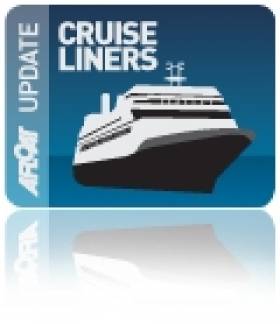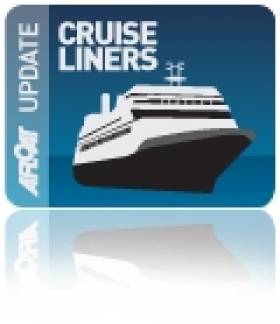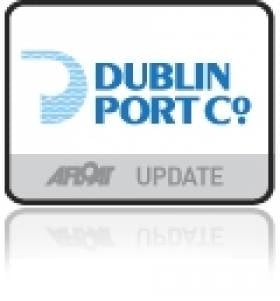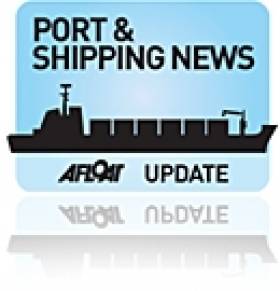Displaying items by tag: Dublin Port Masterplan
The Gathering Brings Bonanza with Record Liner Calls to Dublin Port
#GATHERING LINERS – A record number of cruiseships are to call to Dublin Port during the inaugural Gathering in 2013, where for the first time the number of cruiseship calls will surpass 100 during the season, writes Jehan Ashmore.
In 2013 the capital port is to welcome a total of 108 calls, (including several ships making repeat calls) stretching between April to October. Last year, 90 such ships made individual calls to the capital which welcomed 100,000 passengers and bringing between them €35-50m to the local economy.
The rise in cruise calls reflects Dublin Port Company's Masterplan 2012-2040, as previously reported on Afloat.ie, where the masterplan has included identifying the need to construct a new cruise facility by 2015, at the North Wall Quay Extension close to the East Link Bridge.
Launching the season will be the 700 passenger Discovery which although not new to Dublin Port, her arrival in early April will be a first under the Cruise & Maritime Voyages brand, having repalced Ocean Countess. The Discovery will also continue to maintain cruises for owners Voyages of Discovery.
Among the usual operators is Princess Cruises regular Caribbean Princess, however, the Gathering will be attracting several newcomers to include US based operator Carnival Cruises, whose giant Carnival Glory (2003/ 110,239 gross tonnes) has a capacity for almost 3,000 passengers and more than 1,100 crew.
Dublin Port can also look forward in welcoming a maiden port of call by the $547m MSC Magnifica in May. The 294m long newbuild is a larger fleetmate of Mediterranean Shipping Company's MSC Lirica, which last year made a debut docking to Dublin Port and to Cork (Cobh).
Lirica's Call Again Brings ‘Added Value’ to the Capital
#LIRICA CALLS AGAIN – Only on her second cruise call to Dublin Port, MSC Lirica (2003/59,058grt) as previously reported on Afloat.ie, docked this morning into the capital brimming with tallships, adding another attraction for cruise-goers, writes Jehan Ashmore.
The $250m ship, made her maiden call to Ireland just over a fortnight ago with over 3,000 passengers. The 251m long vessel operated by Mediterranean Shipping Company (MSC) Cruises, which is the newest company to enter the Irish market and in total there are 90 callers to Dublin Port in 2012.
In May next year the port is to welcome another MSC Cruises vessel with the larger 293m MSC Magnifica, which cost $547million and was only completed in 2010.
The value of the sector is estimated to generate €35 and €50 million for the local economy, bringing over 100,000 high-spend passengers and crew to the city and surrounding areas' shops, attractions and eateries each year.
Add to that, an estimated 1 million visitors over the four-day Tall Ships festival, not to mention the international crew of 1,500 and attendant publicity. Albeit the tallships festival in Dublin is an infrequent event as it was held in the capital in 1998.
However this is the opposite with the expanding cruise business sector, where increasingly larger liners are making more regular calls. In order to cope with capacity the Dublin Port Company's Masterplan 2012-2040 has proposed a new €110m cruise terminal identified beside the East Link toll-lift bridge, recent witness to the numerous tallships passing through.
On a nationwide basis, over the last two years, it has been estimated that the cruise ship industry has contributed €20.3 million. Noting many cruise-callers make visits to more than one Irish port, particularly those calling to the premier ports, where economic opportunities for the hinterland's could be worth a potential €60 million over the next few years.
The Swiss headquartered MSC group don't just operate cruiseships, and are not new to Ireland, as for several years through their global container shipping division, its operation here, MSC (Ireland) started providing direct container shipping routes.
Initially they used their own tonnage (later chartered vessels) from one of the world's largest containership fleets, where the MSC compass brand symbol can be seen on the mixed fleet but also on the containers themselves.
Cruiseship on Atlantic Repositioning Cruise
#ATLANTIC REPOSITIONING CRUISE – Another massive cruiseship the Caribbean Princess (2004/112,894grt), is to dock in Dublin Port around lunchtime today, having crossed the Atlantic, from Halifax, Nova Scotia in Canada, writes Jehan Ashmore.
The 3,600 passenger capacity 'Grand' class ship operated by Princess Cruises is on a repositioning cruise voyage from North America to Europe. She is to spend the season running cruises based out of Southampton.
Caribbean Princess retains her 'Skywalkers' Nightclub mounted 15 decks at the stern, unlike her sister which called to Dublin Port last month. The structure was removed primarily on grounds of weight so to increase fuel efficiency.
The Bermuda flagged vessel is to berth at Ocean Pier in the centre of the docks which this season is to welcome a total of 90 cruiseships bringing 100,000 passengers contributing €35- €50m to the Dublin economy in 2012. It is estimated that the cruise sector has contributed over €350 million to the capital in the last decade.
Vessels such as the Caribbean Princess and larger-sized ships could be a familar sight closer to the city-centre should proposals to build a €30m dedicated cruise terminal take-off at a site adjacent to the East-Link Bridge, as part of the Dublin Port Company's Masterplan 2012-2040.
Cruise Callers to Dun Laoghaire ‘Recalled’
#DUN LAOGHAIRE CRUISELINERS – The recent call of what is believed to be the world's smallest cruiseship the Quest (1991/1,180grt) to Dun Laoghaire Harbour as part of an initiative to develop this sector is by no means completely new to the harbour, writes Jehan Ashmore.
It was not until a decade ago that the last cruise callers were on the scene, albeit making infrequent visits and they also varied considerably in size. Among the callers was the famous 'Cunarder' Queen Elizabeth 2 or 'QE2', RCCL's Norway formerly French Line's France and Celebrity Cruise then brand new Constellation. Notably these large vessels all made anchorage calls in Dublin Bay.
Constellation made this call in 2002 as did the Sun Bay II which was also then recently launched into service and the cruiseships were making their debut season in European waters. They could not be so different, the 2,800 tonnes Sun Bay II with an 89 passenger capacity in complete contrast to the 90,000 tonnes Constellation with over 1,800 passengers.
The diminutive Sun Bay II was not too dissimilar to Noble Caledonia's Quest in terms of passenger capacity being slightly smaller with a capacity of 52. She was alongside Carlisle Pier where her guests were on a 9-night Garden themed cruise of UK and Ireland that included tours to Powerscourt and Mount Usher in Co. Wicklow.
On the call of Constellation she anchored relatively closer to the shore off Bulloch Harbour, compared to QE2 and Norway's calls and she presented an imposing and impressive sight.
In the case of the Norway, her passengers were ferried to the marina by unusually large tenders more akin to tank landing craft as they bow doors (click PHOTO). In fact they were so large that they could not be stowed on the lifeboat deck and instead located forward of the bridge where deck-mounted cranes were used for hoisting operations.
The practice of anchorage calls will continue as vessels of this size will remain too large to be accommodated in the harbour in the short term, though the Dun Laoghaire Harbour Company's 'masterplan' includes a proposed €18m new cruise terminal. They claim the terminal would be capable of handling the largest and most modern cruiseships in the world.
In the meantime the landing point for tenders to use a new tender dock facility was installed recently at the Traders Wharf, as distinct to the Carlisle Pier (site of proposed Diaspora Museum) where small to medium sized vessels are to berth.
A further three more calls are scheduled this season, including a return call next week of Quest and other vessels capable of carrying around 500 passengers. This figure is to rise considerably in May 2013, thanks mostly due in part to the massive Cunard Line flagship Queen Mary 2 (QM2). The 151,400 tonnes 'liner' can take over 2,600 passengers and 1,200 crew alone.
With the visit of QM2, this is to be her fist call to Dublin Bay, as she is still to be big even for Dublin Port to handle. Likewise the rivals across Dublin Bay in the Dublin Port Company are proposing as part of their masterplan to build a €30m dedicated cruise terminal. This facility would also be able to accommodate very large cruise callers.
It will be interesting to see how both completing ports progress and how they market themselves to the cruise sector industry, no doubt across the board. The giant ships look after large volumes which keep cruise prices down. As for the smaller boutique style of cruiseship operators, they can command higher prices by targeting the top end of the market and where they have higher-spending power at ports of call . The cruise industry overall is becoming increasingly more globalised where it was traditionally the preserve of the European and North American markets.
Arguably it is debatable if there should be two cruise terminals built as it reminiscent of the controversary during the '80's over the battle between which Dublin Bay port would be chosen for the site of a new single dedicated multi-user car-ferry terminal.
As it transpired the ferry service to Holyhead remains operating out of Dun Laoghaire Harbour, where a new terminal was built specifically to dock the revolutionary design of the HSS (High-speed Sea Service) fast craft catamaran car-ferry. Albeit in recent years the route's sailing frequency has reduced considerably. Under the last contract between Stena and the harbour company, this has led to considerably less revenue generated in harbour dues. The HSS Stena Explorer currently maintains only a single daily round-trip and only on a seasonal basis between April-September.
While at Dublin Port a multi-user ferry terminal was built but Stena Line did not immediately become part of the facility. It was not until 1995 that they set up an additional new service from Dublin Port to Holyhead. They use a second adjacent terminal that is currently served by two ferries on the company's second route to Wales.
The need to ensure that Dublin Port and Dublin City are integrated and that the Port "turns its face" to the City, by removing physical barriers to integration and encouraging more people to visit the Port or view the activities taking place in the Port.
Widespread acceptance that Dublin Port is a key part of national strategic infrastructure and plays a key role in the life of the City and the greater Dublin area.
The importance of facilitating international trade in Ireland.
Unanimous agreement that everything possible should be done to encourage and facilitate the increased presence of Cruise Ships in Dublin Port.
General agreement that DPC faces significant challenges in operating and growing the Port in light of the location of the Port alongside sensitive environmental zones.
A common view that DPC should fully exhaust all viable alternatives to meet the operating requirements of the Port before engaging in additional reclamation works.
Widespread recognition that the creation of new port facilities at Bremore or elsewhere was not likely in the medium term given the financial challenges facing such a project in light of current national capacity, the scale of the engineering project involved and current funding.
The process sought views from a wide circle of stakeholders whose views on the operations and future of the port are important. Community briefings attracted over 100 people from Clontarf, East Wall and Ringsend. A conference was attended by 140 key stakeholders, while additional briefings were held with 12 organisations and groups.
Commenting, Mr. Eamonn O'Reilly said: "The objective of growing Dublin Port to allow it to handle 60m tonnes by 2040 is generally regarded as a reasonable basis for long term planning of the port. We are delighted with the response to our consultation process to date and we will make every effort to respond to all inputs we have received.
The Masterplan will help drive our national competitiveness by planning responsibly for an efficient and effective infrastructure to underpin the trading needs of our economy into the future. We are very conscious of the challenge of doing this, while integrating well with the city of Dublin and its citizens and expanding in a responsible and environmentally friendly manner."
Arising from the Consultation Process and the responses to the Issues Paper, there are a number of additional reports and studies that will be considered in the context of finalising the production of the Masterplan and a number of further meetings will be arranged with specific stakeholders.
Varadkar Warns of No Bail-Out to State-Owned Ports
In the report it was noted that there are too many ports and that the sector would benefit from a rationalisation of ownership and management structures. The decision which will be made over the next few months not only concerns the fate of the capital port but also the following state-owned ports: Dun Laoghaire, Waterford, Drogheda, Dundalk, Cork, Shannon Foynes, Wicklow, New Ross and Galway.
Mr Varadkar also warned that state money wouldn't be made available to bolster ports' balance sheets. "Where port companies are not successful, there will no bailouts and there will be no state aid. "It just isn't possible for the Government in the situation it's in to offer that," he said.
"Where smaller ports find themselves unable to continue operations, amalgamations or transfers to local authorities will be the preferred option."
On the issue of selling Dublin Port the company's chief executive Mr. Eamon O'Reilly who has cited previously that the port should not be sold as a private operator would not have the same incentive to invest as they would be focusing on generating returns.
As for the masterplan, he emphasised that the port would need to double its capacity so to handle the expected trade levels by 2040. He conceded the masterplan will cause some controversy but said the port has "great potential" to facilitate economic growth and make Dublin a better city to live in.



































































